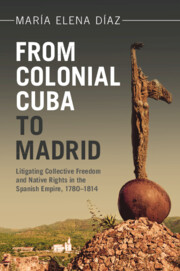 From Colonial Cuba to Madrid
From Colonial Cuba to Madrid Published online by Cambridge University Press: 14 November 2024
Focusing on the afterlife of the Freedom Edict of April 7, 1800, the chapter moves the story into the nineteenth century, a period of imperial crisis that saw the emergence of liberal trends in the empire as well as new stakeholders in the historical context of the island and, more generally, of the Spanish Atlantic world. Chapter 9 focuses on the problems that the emancipated cobreros faced in actualizing a corporate community model along the lines of colonial Indian law. It further compares El Cobre’s predicament in the new period with that of two other recognized Indian pueblos of El Caney and Jiguani, a situation that resonated elsewhere in the Spanish Atlantic in the postcolonial Latin American republics. Questions about native rights, race, and citizenship, about civil and political rights, about corporate and individual land rights emerged in this new political context, especially with the globalization of El Cobre. This globalization was linked to the arrival of French refugees and the development of a British mining industry in the region. These emerging trends led to the erasure of major aspects of the Freedom Edict of 1800 by the early 1840s.
To save this book to your Kindle, first ensure [email protected] is added to your Approved Personal Document E-mail List under your Personal Document Settings on the Manage Your Content and Devices page of your Amazon account. Then enter the ‘name’ part of your Kindle email address below. Find out more about saving to your Kindle.
Note you can select to save to either the @free.kindle.com or @kindle.com variations. ‘@free.kindle.com’ emails are free but can only be saved to your device when it is connected to wi-fi. ‘@kindle.com’ emails can be delivered even when you are not connected to wi-fi, but note that service fees apply.
Find out more about the Kindle Personal Document Service.
To save content items to your account, please confirm that you agree to abide by our usage policies. If this is the first time you use this feature, you will be asked to authorise Cambridge Core to connect with your account. Find out more about saving content to Dropbox.
To save content items to your account, please confirm that you agree to abide by our usage policies. If this is the first time you use this feature, you will be asked to authorise Cambridge Core to connect with your account. Find out more about saving content to Google Drive.